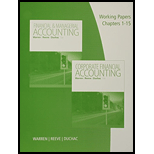
Working Papers, Volume 1, Chapters 1-15 for Warren/Reeve/Duchac's Corporate Financial Accounting, 13th + Financial & Managerial Accounting, 13th
13th Edition
ISBN: 9781285869582
Author: Carl Warren, James M. Reeve, Jonathan Duchac
Publisher: Cengage Learning
expand_more
expand_more
format_list_bulleted
Concept explainers
Question
Chapter 6, Problem 6.1APE
(a)
To determine
Cost flow assumptions:
Cost flow assumptions can be referred to as the method which determines the flow of costs when an inventory is sold. Instead of keeping a track record for cost of each product sold, a company adopts these methods, and identifies which units were sold. It differs from specific identification method because the actual physical movement of goods may be unrelated to the flow of costs.
To determine: Gross profit and ending inventory under First-in-first out (FIFO) method.
(b)
To determine
Gross profit and ending inventory under Last-in-first out (LIFO) method.
(c)
To determine
Gross profit and ending inventory under weighted average inventory method.
Expert Solution & Answer
Want to see the full answer?
Check out a sample textbook solution
Students have asked these similar questions
I want to this question answer for General accounting question not need ai solution
Managerial accounting questions ⁉️
Get correct answer with general accounting
Chapter 6 Solutions
Working Papers, Volume 1, Chapters 1-15 for Warren/Reeve/Duchac's Corporate Financial Accounting, 13th + Financial & Managerial Accounting, 13th
Ch. 6 - Before inventory purchases are recorded, the...Ch. 6 - Why is it important to periodically take a...Ch. 6 - Do the terms FIFO, LIFO, and weighted average...Ch. 6 - If inventory is being valued at cost and the price...Ch. 6 - Which of the three methods of inventory...Ch. 6 - If inventory is being valued at cost and the price...Ch. 6 - Using the following data, how should the inventory...Ch. 6 - Prob. 8DQCh. 6 - Hutch Co. sold merchandise to Bibbins Company on...Ch. 6 - A manufacturer shipped merchandise to a retailer...
Ch. 6 - Prob. 6.1APECh. 6 - Prob. 6.1BPECh. 6 - Perpetual inventory using FIFO Beginning...Ch. 6 - Perpetual inventory using FIFO Beginning...Ch. 6 - Perpetual inventory using UFO Beginning inventory,...Ch. 6 - Perpetual inventory using LIFO Beginning...Ch. 6 - Perpetual inventory using weighted average...Ch. 6 - Perpetual inventory using weighted average...Ch. 6 - Periodic inventory using FIFO, LIFO, and weighted...Ch. 6 - Periodic inventory using FIFO, UFO, and weighted...Ch. 6 - Prob. 6.6APECh. 6 - Lower-of-cost-or-market method On the basis of the...Ch. 6 - Prob. 6.7APECh. 6 - Prob. 6.7BPECh. 6 - Inventory turnover and number of days' sales in...Ch. 6 - Inventory turnover and number of days' sales in...Ch. 6 - Control of inventories Triple Creek Hardware Store...Ch. 6 - Prob. 6.2EXCh. 6 - Perpetual inventory using FIFO Beginning...Ch. 6 - Perpetual inventory using LIFO Assume that the...Ch. 6 - Perpetual inventory using LIFO Beginning...Ch. 6 - Perpetual inventory using FIFO Assume that the...Ch. 6 - FIFO and LIFO costs under perpetual Inventory...Ch. 6 - Prob. 6.8EXCh. 6 - Prob. 6.9EXCh. 6 - Prob. 6.10EXCh. 6 - Prob. 6.11EXCh. 6 - Prob. 6.12EXCh. 6 - Periodic inventory by three methods; cost of...Ch. 6 - Comparing inventory methods Assume that a firm...Ch. 6 - Lower of cost or market inventory On the basis of...Ch. 6 - Merchandise inventory on the balance sheet Based...Ch. 6 - Effect of errors in physical inventory Missouri...Ch. 6 - Effect of errors in physical inventory Fonda...Ch. 6 - Prob. 6.19EXCh. 6 - Prob. 6.20EXCh. 6 - Prob. 6.21EXCh. 6 - Prob. 6.22EXCh. 6 - Retail method A business using the retail method...Ch. 6 - Retail method A business using the retail method...Ch. 6 - Retail method On the basis of the following data,...Ch. 6 - Gross profit method The inventory was destroyed by...Ch. 6 - Prob. 6.27EXCh. 6 - Gross profit method Based on the following data,...Ch. 6 - FIFO perpetual inventory The beginning inventory...Ch. 6 - Prob. 6.2APRCh. 6 - Prob. 6.3APRCh. 6 - Prob. 6.4APRCh. 6 - Prob. 6.5APRCh. 6 - Prob. 6.6APRCh. 6 - Prob. 6.7APRCh. 6 - FIFO perpetual inventory The beginning inventory...Ch. 6 - Prob. 6.2BPRCh. 6 - Weighted average cost method with perpetual...Ch. 6 - Prob. 6.4BPRCh. 6 - Prob. 6.5BPRCh. 6 - Prob. 6.6BPRCh. 6 - Retail method; gross project method Selected data...Ch. 6 - Prob. 6.1CPCh. 6 - Prob. 6.2CPCh. 6 - Costing inventory Golden Eagle Company begun...Ch. 6 - Inventory ratios for Dell and HP Dell Inc. and...Ch. 6 - Prob. 6.5CPCh. 6 - Prob. 6.6CP
Knowledge Booster
Learn more about
Need a deep-dive on the concept behind this application? Look no further. Learn more about this topic, accounting and related others by exploring similar questions and additional content below.Similar questions
arrow_back_ios
SEE MORE QUESTIONS
arrow_forward_ios
Recommended textbooks for you
- Principles of Accounting Volume 1AccountingISBN:9781947172685Author:OpenStaxPublisher:OpenStax College
 Financial AccountingAccountingISBN:9781337272124Author:Carl Warren, James M. Reeve, Jonathan DuchacPublisher:Cengage Learning
Financial AccountingAccountingISBN:9781337272124Author:Carl Warren, James M. Reeve, Jonathan DuchacPublisher:Cengage Learning Financial AccountingAccountingISBN:9781305088436Author:Carl Warren, Jim Reeve, Jonathan DuchacPublisher:Cengage Learning
Financial AccountingAccountingISBN:9781305088436Author:Carl Warren, Jim Reeve, Jonathan DuchacPublisher:Cengage Learning  College Accounting, Chapters 1-27AccountingISBN:9781337794756Author:HEINTZ, James A.Publisher:Cengage Learning,
College Accounting, Chapters 1-27AccountingISBN:9781337794756Author:HEINTZ, James A.Publisher:Cengage Learning, Financial Accounting: The Impact on Decision Make...AccountingISBN:9781305654174Author:Gary A. Porter, Curtis L. NortonPublisher:Cengage Learning
Financial Accounting: The Impact on Decision Make...AccountingISBN:9781305654174Author:Gary A. Porter, Curtis L. NortonPublisher:Cengage Learning

Principles of Accounting Volume 1
Accounting
ISBN:9781947172685
Author:OpenStax
Publisher:OpenStax College

Financial Accounting
Accounting
ISBN:9781337272124
Author:Carl Warren, James M. Reeve, Jonathan Duchac
Publisher:Cengage Learning

Financial Accounting
Accounting
ISBN:9781305088436
Author:Carl Warren, Jim Reeve, Jonathan Duchac
Publisher:Cengage Learning


College Accounting, Chapters 1-27
Accounting
ISBN:9781337794756
Author:HEINTZ, James A.
Publisher:Cengage Learning,

Financial Accounting: The Impact on Decision Make...
Accounting
ISBN:9781305654174
Author:Gary A. Porter, Curtis L. Norton
Publisher:Cengage Learning
Chapter 6 Merchandise Inventory; Author: Vicki Stewart;https://www.youtube.com/watch?v=DnrcQLD2yKU;License: Standard YouTube License, CC-BY
Accounting for Merchandising Operations Recording Purchases of Merchandise; Author: Socrat Ghadban;https://www.youtube.com/watch?v=iQp5UoYpG20;License: Standard Youtube License